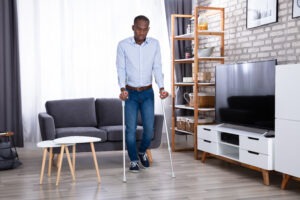
In order to prove that you or your loved one is suffering from a catastrophic injury, you must first fully understand what a catastrophic injury is. Catastrophic injuries deal with permanent damage to your body or mind. You may never be able to fully recover from a catastrophic injury and its effects on you.
A personal injury lawyer must establish 4 different elements of the at-fault party’s negligence to have a fighting chance at recovering financial compensation for your damages. Those 4 different elements include duty of care, breach of duty, causation, and damages. It is important to know and understand these elements clearly so you can have a good idea as to whether or not your catastrophic injury case can be successful at trial.
Duty of Care
Duty of care can be a more confusing concept for catastrophic injury victims to understand. It means that the at-fault party had a responsibility to act in a reasonable manner to help avoid causing you harm. Failure to act reasonably to help prevent harm means the individual disobeyed a duty of care. If there is no duty of care, then there is no reason to sue someone for a personal injury lawsuit.
For example, in motor vehicle accidents, the at-fault party has to drive in accordance with the rules of the road (state and federal laws). Otherwise, they will get into an accident that can potentially cause harm to themselves and others. The at-fault party violated their duty of care if they t-boned someone’s car when running a red light.
Our Team Is Here To Assist You Every Step Of The Way.
SPEAK TO AN ATTORNEY TODAYBreach of Duty
Once establishing a duty of care, you must prove that the duty of care was disobeyed, violated, or breached. You would not have gotten seriously injured, and you would not be filing a lawsuit if the at-fault party had closely adhered to the duty of care. In the same example above, running that red light and t-boning an individual’s car would be a breach of duty of care. They simply did not care about that person’s safety or well-being when performing that reckless action.
Causation
Not only do you and your legal counsel have to prove that there was a duty of care and that the duty of care was violated, but you must also prove causation. This means that you must prove that the at-fault party breaching the duty of care was the direct cause of the accident and your catastrophic injuries. Failure to prove this, despite proving a breach of duty of care, means that you could lose your opportunity to recover damages from the accident.
You will need to have solid evidence to prove the at-fault party’s breach of duty as direct causation. Your team can use police records, medical exams, insurance reports, and witness testimonies as your evidence for the causation. Your personal injury attorneys must also disprove and discredit the evidence that the at-fault party’s team puts together and showcases.
Damages
With any personal injury lawsuit, you must be able to prove the damages that you have suffered as a result of the accident. Your best shot at proving the damages would be displaying a vast swath of solid evidence. There is no point in filing a claim with personal injury lawyers if there can be no evidence obtained.
An experienced personal injury lawyer from Boettcher, Divenney, Ingle, and Wicker (BDIW) can help gather and demonstrate this evidence for you. Our team plans on utilizing evidence from a ton of different sources. This includes:
- Medical records
- Medical bills
- Therapy costs
- Prescription drug costs
- X-ray results
- Blood test results
- Other medical test results
- Testimonies of physicians and other medical personnel
- Records from your employer
This evidence can help prove the full extent of your damages, pain, and suffering. After we present all of the evidence, our case will be in tip-top shape to be able to recover damages and hold the at-fault party accountable for their reckless actions.
Statute of Limitations on Catastrophic Injury Cases
Establishing those 4 crucial elements will not mean anything if it is not done within the statute of limitations. Every personal injury case, including those dealing with catastrophic injuries, has a period of time when you are legally allowed to file a claim. Once you pass that threshold, you are prohibited from filing a lawsuit and seeking compensation, even if your catastrophic injuries make it difficult for you to be able to do anything outside of basic life necessities.
Every state has different laws pertaining to statutes of limitation for personal injury cases. The average time span for a statute of limitations is 2-4 years. In the state of Oklahoma, the law says you have 2 years from the onset of the accident and the injuries to file a formal claim.
Example of Proving a Catastrophic Injury
According to the Centers for Disease Control and Prevention (CDC), there are many different types of injuries that could be classified as catastrophic. Loss of limbs, burns, organ damage, spinal cord injuries, paralysis, and traumatic brain injuries can all be legally defined as catastrophic. Let’s say that you suffered the loss of your legs (and therefore your ability to walk) from a motor vehicle accident, for our example.
First, you may only file a claim for this Oklahoma-based catastrophic injury case if it has been less than 2 years since the onset of the accident. From there, you can chat with a seasoned BDIW catastrophic injury attorney about your legal options going forward. We plan on establishing a duty of care (which is the rules of the road when driving) and a breach of that duty of care.
The breach of duty for this example would be the at-fault party violating the traffic laws and harming you in the process. Proving that this breach of duty was the direct cause of your loss of legs would be our next step. Collecting police records and witness testimonies from the scene of the accident would be the best plan of action for this.
Finally, displaying the full extent of your damages will help our chances of recovering compensation for your pain and suffering. Medical records and medical bills, along with testimonies from doctors who have tended to your catastrophic amputations, should be more than sufficient.








